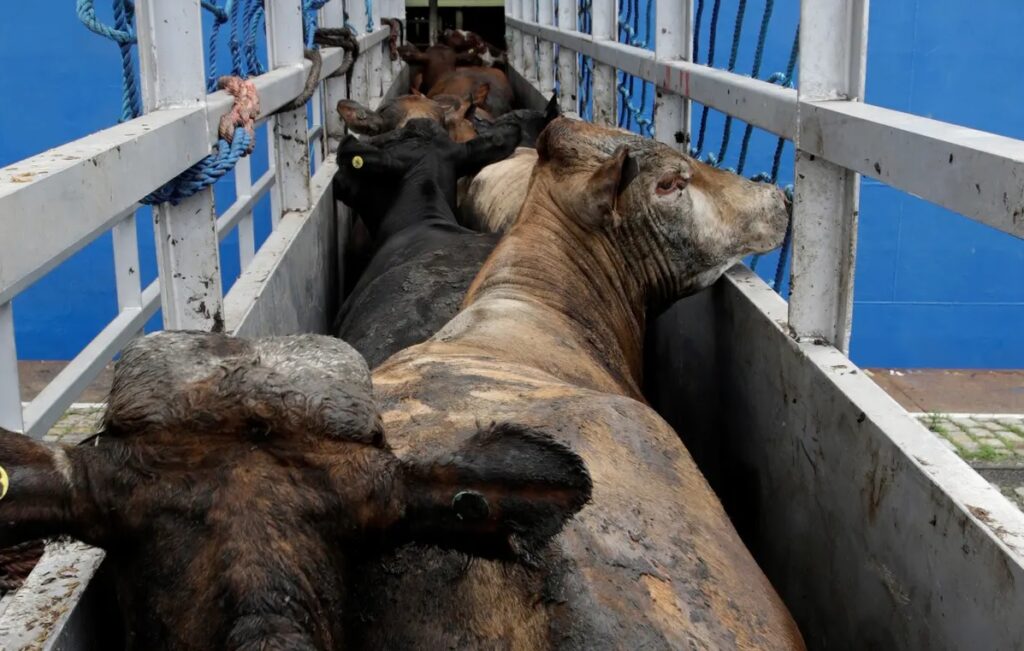The EU’s claim to have the world’s highest animal welfare standards is undermined by its huge live farmed animals transport industry among its member states and exports to distant third countries.
As others dismantle their live animal transport industry, the European Union insists on pressing ahead with this cruel trade despite scientific and veterinary advice that the trade should be ended.
Britain, which at its height was exporting two million sheep a year for slaughter abroad and 500,000 calves to be reared for veal, has now banned live exports for slaughter or fattening. Australia used to export four million sheep a year for slaughter in the Middle East but has recently announced that live sheep exports by sea will be banned from May 2028.
Suffering on journeys from EU each year
Each year the EU exports around three million sheep and goats and one million cattle to non-EU countries - mainly to the Middle East and North Africa. A Data Dump of Suffering, a recent report by Compassion in World Farming and Eurogroup for Animals, highlights the immense cruelty caused by this trade.
For many the ordeal begins with a long road journey to a southern European seaport. On arrival, lengthy delays can occur before loading onto the ship begins. During these delays the animals are often left on board stationary trucks without mechanical ventilation in very hot summer weather; the temperature inside the vehicle can increase rapidly leading to heat stress.
The handling of animals during loading is often rough. Sticks and electric prods are sometimes being used to force animals up steep ramps. Once on the ship, the animals are packed into crowded, often poorly ventilated pens. The accumulation of manure and urine during the journey results in increased levels of harmful gases, mostly ammonia, carbon dioxide, and hydrogen sulphide.
During the protracted sea journeys water troughs sometimes get dirty and the bedding gradually becomes very wet and soiled; in some cases, animals are covered in faeces. There is no veterinarian on board the ships and so there is no-one able to treat animals who become diseased or injured. The sea journey typically lasts from 5 to 8 days but may be as long as several weeks. The largest livestock vessels can transport around 18,000 cattle or 75,000 sheep.
EU completely ignores its own scientific advisers
The EU’s reluctance to recognise the suffering involved in these long journeys contrasts sharply with statements made during a recent Brazilian court case. Brazil also exports cattle by sea to the Middle East. Last year, Brazil’s National Forum for the Protection and Defence of Animals brought a court case challenging the legality of the trade.
The veterinarian who inspected a livestock vessel at the Judge’s request concluded: “the practice of maritime transport of animals over long distances is intrinsically and inherently related to the causation of cruelty, suffering, pain, indignity and corruption of animal welfare in various forms”.
The European Food Safety Authority (EFSA) is responsible for producing scientific opinions to inform the EU’s policy on animal welfare. Recent EFSA reports stress that the severity of hunger, thirst and fatigue will increase over time during these long journeys within the EU and to third countries, and recommend that for the benefit of animal welfare, the journey duration should be kept to a minimum.
One EFSA report, ‘Welfare of pigs during transport’, dated September 2022, highlighted that pigs are the mammalian species, that are transported in the highest numbers in the EU by far. 31 million pigs were transported between member states per year in the period from 2019 to 2021. Road transport constituted 99% of total pig transport.
On top of that, 83% of Europeans think that the travel time for the transport of live animals within or from the EU should be limited. However, in its 2023 proposal for Regulation on the protection of animals during transport, the European Commission completely ignored scientific advice and citizens’ opinions, and allowed the continuation of this ruthless live export trade.
Animals have minimal welfare protection on leaving EU
EU animals sent to the Middle East, North Africa and Turkey are often slaughtered in an inhumane manner. Most of the problems are unrelated to slaughter practices associated with religious beliefs, known as ‘religious slaughter’. In EU law, the balance between freedom of religion and animal welfare protection is left to the discretion of the member states. A majority of them allows slaughter without prior stunning.
The suffering mainly arises because of inhumane handling that have nothing to do with religious requirements. For examples, in Egypt unskilled slaughtermen have been known to routinely control cattle by severing their leg tendons with a knife. Often in this region a chain is tied round a rear leg of cattle. The fully conscious animal is then hoisted up, dangling upside-down from one back leg, ready for slaughter.
The EU should not only strengthen its own legislation on slaughter to ensure all animals are properly stunned, but also take inhumane slaughter methods into account when considering the ethics of its live export trade.
Each year, on 14 June we – along with NGOs and supporters across the world - commemorate Ban Live Exports International Awareness Day. This day marks the anniversary of 13,000 sheep losing their lives when exported from Romania to Jordan and then Somalia in 2015. Nine years on, Britain has banned the trade, and other countries are taking steps to do so. It is vital that the EU lives up to its boast of having world leading animal welfare standards by banning its cruel live exports trade.


